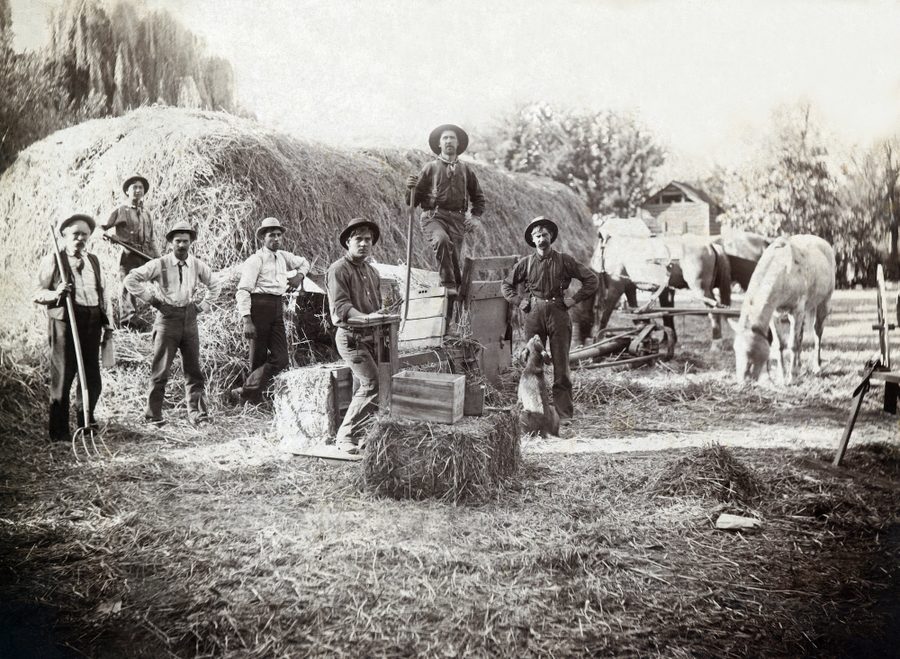Donald Trump Makes a Mockery of Populism
To call Trump a “populist” is to desecrate the memory of the 19th century movement that took on robber barons like him.
Tim Brinkhof

Editor’s Note: This review of Forgotten Populists: When Farmers Turned Left to Save Democracy by Steve Babson (Mission Point Press, 2023) was originally published by Jacobin.
If you’ve been following the buildup to next year’s U.S. presidential election, you have almost certainly come across an article that describes Donald Trump and his campaign as “populist.” At first glance, there appears to be nothing wrong with this observation. After all, populism has become synonymous with unscrupulous leaders who prey on the voting public’s worst impulses.
However, populism has a progressive history which these narratives ignore. As the former labor educator and union activist Steve Babson shows in his book, Forgotten Populists: When Farmers Turned Left to Save Democracy, populism actually used to mean the complete opposite of what it has come to mean. In the 1890s, populism was an umbrella term for different political movements organized by the U.S. working class. Far from threatening democracy, their goal was to limit and reduce the power of the country’s monied elite.
The rural United States, one of Trump’s biggest bases of support, writes Babson, would have been his greatest enemy at the turn of the last century. Exploited by millionaires and billionaires from the East Coast, its residents were deeply suspicious of wealth — and rightly so, as many lived on the very edge of poverty while robber barons like John D. Rockefeller, Cornelius Vanderbilt, and Andrew Carnegie hoarded fortunes of hitherto unseen proportions.
But Babson’s book is not just an exercise in historical research — it is an intervention in public debates around democracy and U.S. history. Forgotten Populists, written in plain, compelling language and only around fifty pages in length, doubles as a kind of political pamphlet. By excavating populism’s now-obscured past, the author hopes to salvage its future. “Recovering the historical meaning of the Populist challenge to corporate absolutism,” the introduction reads, “is a first step in linking that past to current struggles against the corporate behemoths and right-wing authoritarians of our time.”
The stage of this story is the Gilded Age, a period of rapid industrialization and urbanization spanning from 1877 to 1900. It was a time in which the United States emerged as a global superpower. It was also a period of grotesque exploitation, as industrializing capitalism broke apart traditional communities and proletarianized subsistence farmers and small-scale producers. In this tumultuous environment, close ties between governments and corporations allowed the latter to push for tax breaks and to consolidate monopolies. In 1892, just 9% of the population controlled 71% of the country’s wealth.
Whether you worked in the field or in a factory, your oppressors used the same tactics. In the countryside, white and black farmers ended up shackled by “crop liens,” leasing seeds and supplies from merchants at interest rates that could climb as high as 100%. In the city, New York bankers held the national economy hostage with their devotion to the gold standard, artificial scarcity ensuring paper money remained limited and, consequently, costly to borrow.
“Widespread destitution is found in the midst of the greatest abundance,” observed political economist Henry George in his 1879 bestseller Progress and Poverty. An emphatic illustration of this point, cited by Babson, comes from the wife of a Kansas smallholder, who in 1894 penned a letter to the state governor “to let you know we are starving to death” after hailstorms destroyed their cash crop.
According to Babson, lower-class resistance “came to a boil in the late 1880s as more farmers lost patience with a system that, in their eyes, privileged the rich at their expense.” Discontent was channeled into two organizations: the Farmers’ Alliance and, later, the People’s Party. Born in Texas, a popular destination for fugitive crop-lieners, the Farmers’ Alliance quickly grew more than one million members, attracting not just agriculturalists but miners, railroad workers, ministers, doctors, and schoolteachers.
Inclusivity expanded from profession to religion, gender, and — albeit to a lesser extent — even race. While predominantly Christian in makeup, Babson points out that Christianity only served the Alliance insofar as it overlapped with the principles of socialism. “Christ did not come to prepare men for another world,” a minister from Texas declared, “but to teach them how to rightly live in this.” “The Alliance,” clarifies Babson, “would be their moral instrument for a collective and earth-bound salvation.”
Embracing the expanding social role of women, the Alliance eagerly recruited members of both sexes, with one chapter going as far as to fine husbands who did not provide a “plausible excuse” for showing up without their wives. “The Alliance,” announced organization leader Bettie Gay, “has come to redeem woman from her enslaved condition. She is admitted into the organization, as the equal of her brother.”
The same invitation did not extend to African Americans, who, in keeping with the practice of segregation, had to set up their own, parallel movements.
One of the Alliance’s biggest legacies was the creation of cooperative exchanges, trade unions that allowed farmers and workers to pool and to sell their labor at a fair price. Fighting “capital with capital,” the Alliance came up with an even more audacious plan: opening a chain of government-owned sub-treasury warehouses where farmers could store their harvests while waiting for better crop prices.
Rather than lobbying politicians from the sideline, the Farmers’ Alliance eventually decided to enter the ring and launch a third-party slate, fusing with the workers’ federation the Knights of Labor to form the People’s Party. Mobilizing members from both groups, candidates running this slate scored small but significant congressional victories in several flyover states, threatening to upset the balance of power between the Democrats and Republicans.
“The new party called for a dramatic turn in public policy,” writes Babson, promising to expand the “small government” championed by robber barons. In doing so, they hoped to turn a state previously “powerless when confronted with the growing might of Big Business” into one capable of ending “oppression, injustice and poverty.” In addition to establishing sub-treasuries, the populists also demanded public ownership of banks and railroads.
Needless to say, many of these goals were never achieved. Despite championing reforms that were eventually accepted decades later, such as the end of dollar to gold convertibility which Nixon initiated in 1971, the People’s Party failed to secure a nationwide victory it needed to survive and thrive. Going through possible explanations, Forgotten Populists lists not just electoral fraud and voter intimidation — for every rural Black person who voted on their own terms, two others were hauled off to the booths by Democrats and threatened with nooses if they refused to comply — but also the smear campaigns of the movement’s rivals. Fearing for their positions, conservative leaders brandished the populists as “radicals,” “would-be revolutionists” and “enemies of God and Man,” labels that stuck.
The fall of the short-lived People’s Party coincided with the rise of the probusiness congressman William McKinley. Although McKinley’s presidency, which ended in his assassination, was equally short-lived, it accelerated many trends the populists had attempted to reverse. Chief among these was the gutting of the Sherman Anti-Trust Act, which permitted giants like U.S. Steel to grow even bigger.
On top of this mounting challenge, events of the twentieth century did little to restore populism’s waning popularity among voters, with the Cold War against communist Russia and China and the resulting Red Scare permanently stunting mainstream support for socialist policies in the United States.
It was during the Scare, actually, that the term “populist” started to acquire its present-day connotations. Here, Babson points to the influence of historian Richard Hofstadter, who attempted to show that the “status anxiety” driving the working poor as the roots of McCarthyism. Although they have long been refuted in academic circles, Hofstadter’s ideas continue to circulate among the general public, encouraging people to think about the “proletariat” as little more than an impulsive, irresponsible mob in search of strawmen to destroy.
In reality, though, Joseph McCarthy has as much in common with the populists as Trump. Far from destroying democracy, Gilded Age populists sought only to protect it. Instead of tearing society apart, the populist movement saw people from various walks of life put aside their differences and fight as one against a common enemy.
Defining populism is by no means a semantic issue. At stake in discussions of the term is the question of the role of the multiracial working class in U.S. history. As Babson notes towards the end of his book, the way the term is currently being used isn’t helping anybody except for the people it is used to describe. First and foremost, to call someone like Trump a populist is to desecrate the memory of the original movement and the genuinely positive and much-needed changes it stood for. Even worse, it prevents us from seeing these modern-day “populists” for what they really are: the next generation of robber barons.
Editor’s Note: This review of Forgotten Populists: When Farmers Turned Left to Save Democracy by Steve Babson (Mission Point Press, 2023) was originally published by Jacobin.
Tim Brinkhof is a Dutch journalist based in Atlanta. He studied comparative literature at New York University and has written for Vulture, JSTOR Daily, and New Lines.




